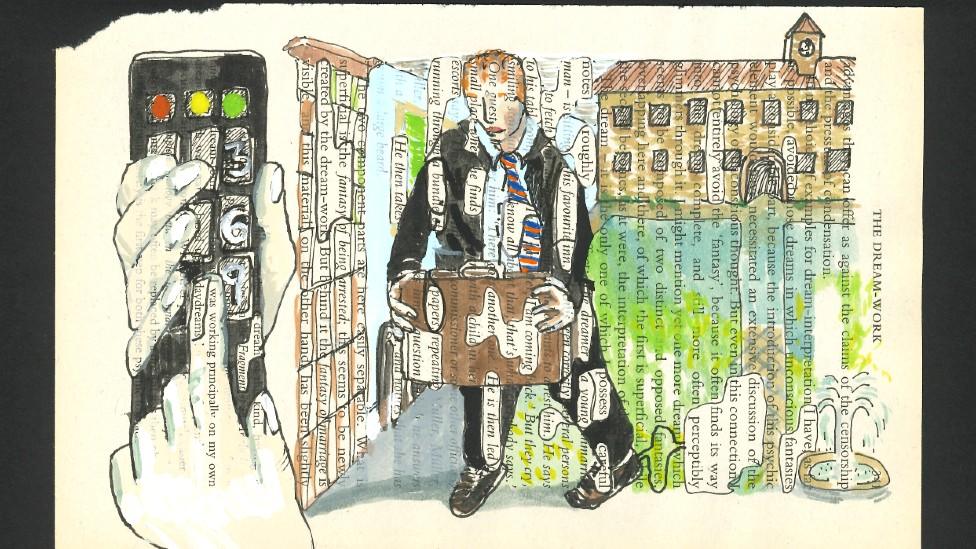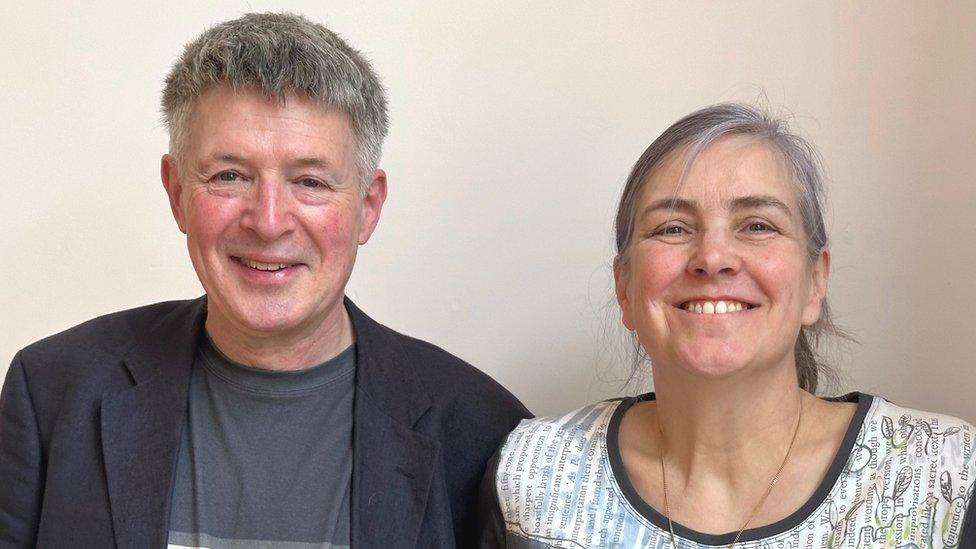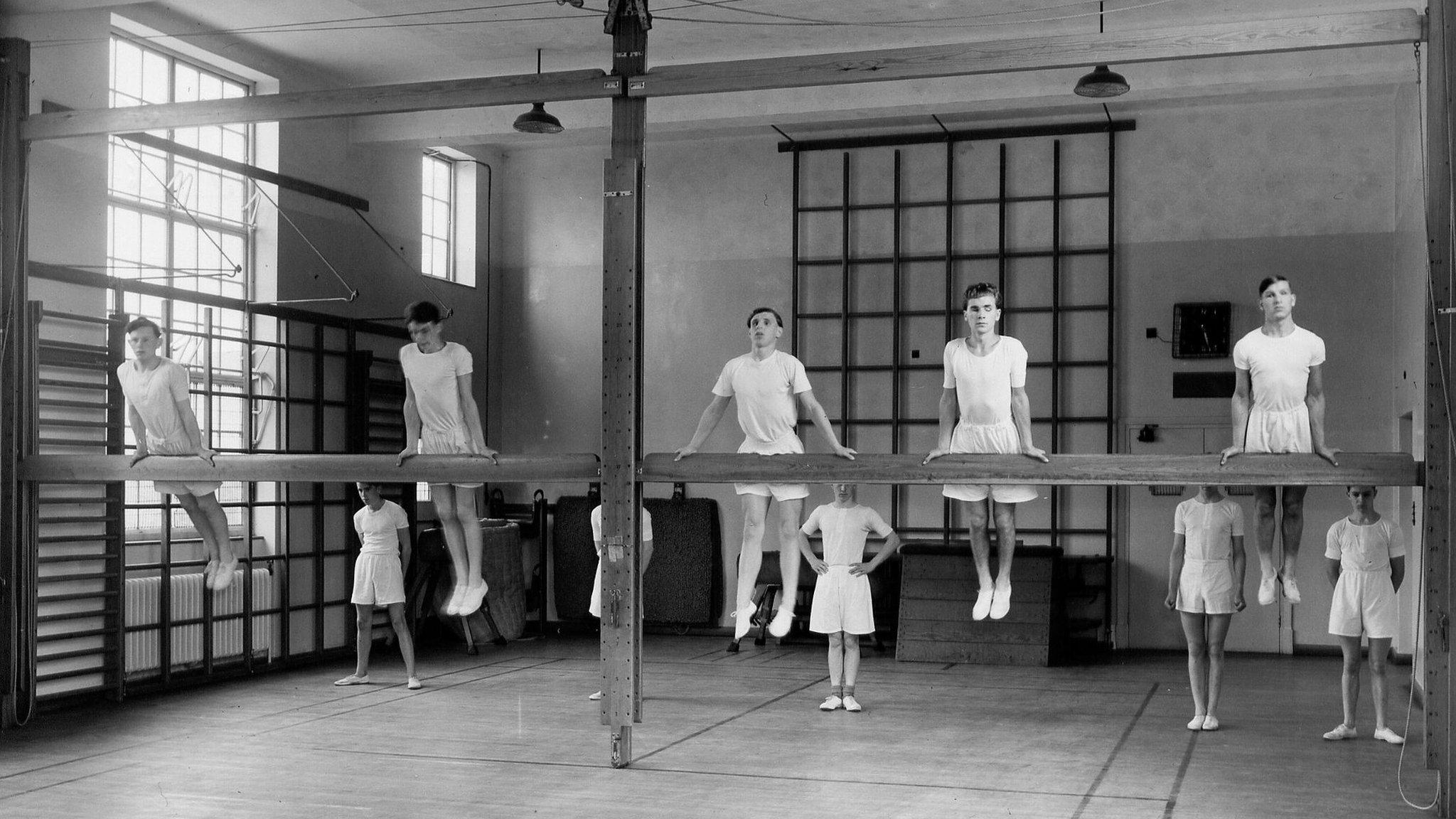Dreams: Can a drawing help unravel their secrets?
- Published

Neil Prior's recurring dream is given shape by Dr Julia Lockheart
For as long as I can remember - at least once a week - I have experienced a recurring dream.
Not exactly a nightmare, but nevertheless something which has confused and troubled me.
I'm something of a counselling cynic, but when I heard about a sleep scientist and artist who had teamed up to try and interpret and explain our dreams, I was intrigued to see if they could get to the bottom of my concerns.
Prof Mark Blagrove interviews people about their dreams, and Dr Julia Lockheart, a renowned artist from Swansea Art College, sketches their discussions to provide greater insight into their meaning.
I am now 44, but in my dream I am 14 or 15 and transported back to my boarding school for blind and visually impaired students in Worcester.
As it is 30 years hence, I am utterly confused as to what lessons I should be attending and where my files and textbooks are.
Nevertheless I possess a superpower: I know everything that will happen in the next 30 years.
To laughter, I try to explain to my classmates that by 2023 their mobile phones will be several times more powerful than our entire school network.
I know who will win that year's FA Cup final, who will win the general election and which horse will succeed in the Grand National.
I am desperately trying to put bets on with a bookie or call my partner Sarah, who I did not meet until 2013.
However, everything on which I try to make a phone call is anything but a mobile - a pocket calculator, a TV remote control… nothing can connect me to the present day.

Prof Mark Blagrove interprets Neil's dream while Dr Julia Lockheart draws it
As Prof Blagrove explains I have fears about getting my ideas across to other people - something of a problem for a BBC feature writer - Dr Lockheart creates an uncanny visual representation. She had no previous knowledge of the school where I grew up.
Her pictures are drawn on pages of Freud's book The Interpretation of Dreams.
She explained: "The text has many linked words which are like the surrealist idea of object trouvé, or found objects, which I make into found poetry. An example of this is in the pointing finger in your hand which is dialling numbers on the TV remote, held tightly in your other hand.
"The sentence 'I was working principally on my own' is highlighted. It runs down the pointing digit which is punching the numbers in to make an impossible phone call.
"We have been given permission from the publishers of Freud for me to paint on to his writing and tear it out of the book to create a piece of psychological art."
Prof Blagrove said this was where art becomes science.
"Julia's paintings bring our dreams to life.

New College, Worcester, where Neil went to school
"We know through our empirical research that people who share their dreams have more empathy with each other, and seeing a visual interpretation only facilitates that process."
He added while there were many schools of thought about the nature and purpose of dreams, theirs was the only scientifically-proven research.
"There is a big body of consensus that dreaming has a biological function in terms of sorting and analysing thoughts from short-term to long-term memory.
"I don't necessarily disagree with that, but it's an unproven theory.
"What we can categorically say - through controlled experiments - is that people who share their dreams and have seen Julia's imagining of them have greater empathy for each other than people who have met for the first time."

Prof Blagrove and Dr Lockheart are starting an international tour to promote their dream analysis work
Prof Blagrove argues that this sort of discussion of our dreams leads to better social cohesion.
Dr Lockheart concurred, saying sharing dreams through art was as old as life itself.
"From prehistoric cave art to Native Americans, there has been a Shamanistic connection with people sharing their dreams."
Many of the dreams shared by NHS professionals during the pandemic followed my pattern.
Dr Lockheart said: "Especially during the early days, nurses were telling us that they knew what was to come, and how it would impact on humanity.
"It's a bit like your dream, insofar as they have information that no-one else does, but they're powerless to control the situation.
"They described horribly disfigured trees, and even one when a cat was sat on their face smothering them."
Prof Blagrove and Dr Lockheart have just released a book based on their seven-year research findings called The Science and Art of Dreaming.
They are about to undertake a European and American tour of their dream analysis, including at the Hay Book Festival in May.
Related topics
- Published14 November 2012

- Published8 May 2021

- Published10 April 2012
